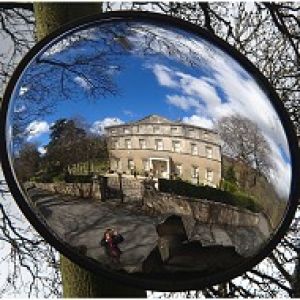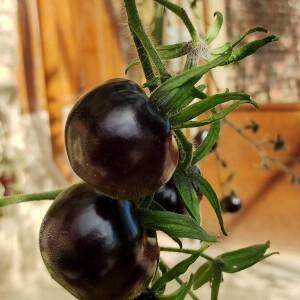The walled garden, Bishop Auckland
The walled garden belongs to the estate of the Bishop's palace. These days it's managed by The Auckland Project.
Extra is of black tomatoes (heritage variety)
Update: Bishop Auckland is a former mining town under regeneration. Parts of it are highly impressive, while the original town is sad and run-down. You can read about the improvements on Wikipedia: https://en.m.wikipedia.org/wiki/Bishop_Auckland We are staying at the boutique hotel which is part of the Auckland project, and very impressive it is, too! The Spanish art gallery mentioned in the Wiki article is now open, but I didn't go there.
We started at the modern Tower, which gives a good overview of the town, and has lifts for those that struggle with stairs. Since I wouldn't be seeing the outdoor son et lumiere at the nearby arena at Kynren, the guide told me the highlights of the show. I now know how to turn back time!
Next stop the Faith Museum. There was a Saxon cross which had fallen over in a storm in Lindisfarne in 1990, that had been reassembled and had patterns and fragments of poetry projected over it. I could have watched that for a very long time, but as it was, I had to drag D away from the first gallery (I think there were five) because I knew he wanted to see the Bishop's Palace, and he was reading every caption! Time management is not one of his skills. We had lunch in a modern cafe in an ancient building, then D went to the Bishop's Palace, and I explored the Walled Gardens, the subject of today's blip, and the town (many charity shops; I didn't linger. The walled garden were only opened this year, and are spectacular. The greenhouse is curved, and is almost as large as something you'd see at Kew Gardens. I found these gardens very tranquil.
Next stop, the Miners' Gallery . Many miners learned to paint in their spare time, and produced unique scenes of life underground. The Spennymoor Settlement and the Ashington colliery group are the best known of the 'schools', and Norman Cornish is perhaps the best known of the mining artists. There was also an exhibition of artwork around the miners strike of 1984-5, 4O years ago , a bloody conflict that is etched on my memory because of the violent scenes we saw on our screens or in the papers every day. The North Eastern coalfield was the largest in the UK. The artwork itself was very strong, reminded me of my trip to Belfadt and Derry earlier this year. History suddenly made real. The guides in the museum were excellent, and I bought a book ,to learn more about the pitmen painters.
Outside in the square, I met D on a bench, and we went for tea in the Town Hall, where there was another Norman Cornish mural on display. It was of the miners' gala banners. D said that his Methodist church in Sheffield used to have such banners at church outings when he was a kid. I associate them more with Trades Unions. C and R and M were the in the cafe too, from our party, and they waved us over. C and R are a gay make couple, and M is their female friend. Apparently someone offered to pray for their souls at the Faith museum. They declined.
We took the bus back and S, who is someone I enjoy talking to at mealtimes, did not abandon our table at dinnertime. To be fair, I had caught up with her in the morning and begged her not to! We therefore had some interesting conversation, and I was able to escape st a reasonable time to my own room and the inevitable packing for departure.
I didn't see everything at Bishop Auckland, so I'll certainly go back. And stay at the same hotel, if I can afford to.


Comments
Sign in or get an account to comment.


